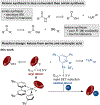Nickel-Catalyzed Synthesis of Dialkyl Ketones from the Coupling of N-Alkyl Pyridinium Salts with Activated Carboxylic Acids
- PMID: 32374951
- PMCID: PMC7397811
- DOI: 10.1002/anie.202002271
Nickel-Catalyzed Synthesis of Dialkyl Ketones from the Coupling of N-Alkyl Pyridinium Salts with Activated Carboxylic Acids
Abstract
While ketones are among the most versatile functional groups, their synthesis remains reliant upon reactive and low-abundance starting materials. In contrast, amide formation is the most-used bond-construction method in medicinal chemistry because the chemistry is reliable and draws upon large and diverse substrate pools. A new method for the synthesis of ketones is presented here that draws from the same substrates used for amide bond synthesis: amines and carboxylic acids. A nickel terpyridine catalyst couples N-alkyl pyridinium salts with in situ formed carboxylic acid fluorides or 2-pyridyl esters under reducing conditions (Mn metal). The reaction has a broad scope, as demonstrated by the synthesis of 35 different ketones bearing a wide variety of functional groups with an average yield of 60±16 %. This approach is capable of coupling diverse substrates, including pharmaceutical intermediates, to rapidly form complex ketones.
Keywords: acyl fluorides; cross-coupling; ketone synthesis; nickel; pyridinium Salts.
© 2020 Wiley-VCH Verlag GmbH & Co. KGaA, Weinheim.
Conflict of interest statement
Figures
Similar articles
-
Synthesis of functionalized dialkyl ketones from carboxylic acid derivatives and alkyl halides.Org Lett. 2012 Mar 16;14(6):1476-9. doi: 10.1021/ol300217x. Epub 2012 Feb 23. Org Lett. 2012. PMID: 22360350 Free PMC article.
-
Ketones from Nickel-Catalyzed Decarboxylative, Non-Symmetric Cross-Electrophile Coupling of Carboxylic Acid Esters.Angew Chem Int Ed Engl. 2019 Aug 26;58(35):12081-12085. doi: 10.1002/anie.201906000. Epub 2019 Jul 30. Angew Chem Int Ed Engl. 2019. PMID: 31287943 Free PMC article.
-
Direct Conversion of Carboxylic Acids to Alkyl Ketones.Org Lett. 2017 Jul 7;19(13):3612-3615. doi: 10.1021/acs.orglett.7b01588. Epub 2017 Jun 12. Org Lett. 2017. PMID: 28604003 Free PMC article.
-
Dehydrogenative Pd and Ni Catalysis for Total Synthesis.Acc Chem Res. 2021 Mar 2;54(5):1118-1130. doi: 10.1021/acs.accounts.0c00787. Epub 2021 Feb 16. Acc Chem Res. 2021. PMID: 33592147 Free PMC article. Review.
-
Mushroom-Mediated Redox Reactions.Chemistry. 2025 Jan 9;31(2):e202403010. doi: 10.1002/chem.202403010. Epub 2024 Dec 12. Chemistry. 2025. PMID: 39632266 Review.
Cited by
-
Traceless Benzylic C-H Amination via Bifunctional N-Aminopyridinium Intermediates.Angew Chem Int Ed Engl. 2022 Jul 11;61(28):e202200665. doi: 10.1002/anie.202200665. Epub 2022 May 20. Angew Chem Int Ed Engl. 2022. PMID: 35483017 Free PMC article.
-
Tunable and Practical Homogeneous Organic Reductants for Cross-Electrophile Coupling.J Am Chem Soc. 2021 Dec 15;143(49):21024-21036. doi: 10.1021/jacs.1c10932. Epub 2021 Nov 30. J Am Chem Soc. 2021. PMID: 34846142 Free PMC article.
-
Oxidative Cross Dehydrogenative Coupling of N-Heterocycles with Aldehydes through C(sp3)-H Functionalization.J Am Chem Soc. 2023 Sep 20;145(37):20176-20181. doi: 10.1021/jacs.3c06532. Epub 2023 Sep 6. J Am Chem Soc. 2023. PMID: 37672664 Free PMC article.
-
Deaminative Reductive Methylation of Alkylpyridinium Salts.Org Lett. 2021 Sep 17;23(18):7059-7063. doi: 10.1021/acs.orglett.1c02458. Epub 2021 Aug 31. Org Lett. 2021. PMID: 34464140 Free PMC article.
-
Deaminative meta-C-H alkylation by ruthenium(ii) catalysis.Chem Sci. 2021 Apr 9;12(23):8073-8078. doi: 10.1039/d1sc00986a. Chem Sci. 2021. PMID: 34194696 Free PMC article.
References
-
- Nahm S, Weinreb SM, Tetrahedron Lett. 1981, 22, 3815–3818.
- Balasubramaniam S, Aidhen IS, Synthesis 2008, 3707–3738.
- Senatore R, Ielo L, Monticelli S, Castoldi L, Pace V, Synthesis 2019, 51, 2792–2808.
- Martín R, Romea P, Tey C, Urpí F, Vilarrasa J, Synlett 1997, 1414–1416.
- Kurosu M, Kishi Y, Tetrahedron Lett. 1998, 39, 4793–4796.
-
- Tokuyama H, Yokoshima S, Yamashita T, Fukuyama T, Tetrahedron Lett. 1998, 39, 3189–3192.
- Hirschbeck V, Gehrtz PH, Fleischer I, Chem. Eur. J 2018, 24, 7092–7107. - PubMed
- Liebeskind LS, Srogl J, J. Am. Chem. Soc 2000, 122, 11260–11261.
- Prokopcová H, Kappe CO, Angew. Chem. Int. Ed 2009, 48, 2276–2286. - PubMed
-
- Cooper TWJ, Campbell IB, Macdonald SJF, Angew. Chem., Int. Ed 2010, 49, 8082–8091. - PubMed
- Roughley SD, Jordan AM, J. Med. Chem 2011, 54, 3451–3479. - PubMed
- Brown DG, Boström J, J. Med. Chem 2016, 59, 4443–4458. - PubMed
- Schneider N, Lowe DM, Sayle RA, Tarselli MA, Landrum GA, J. Med. Chem 2016, 59, 4385–4402. - PubMed
- b). Boström J, Brown DG, Young RJ, Keserü GM, Nat. Rev 2018, 17, 709–727. - PubMed
-
-
For alkyl-X: X = [ZnX], 443 compounds; X = [B], 4225; X = I, 8621; X = Br, 193284; X = CO2H (1°, 2° and 3°), 1385384; X = NH2 (1° and 2°), 1237920; Data from eMolecules Database accessed via REAXYS (April 8, 2019).
-
Publication types
MeSH terms
Substances
Grants and funding
LinkOut - more resources
Full Text Sources


